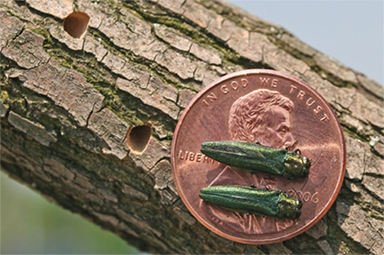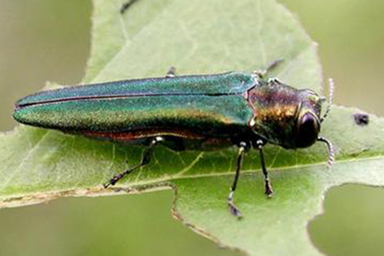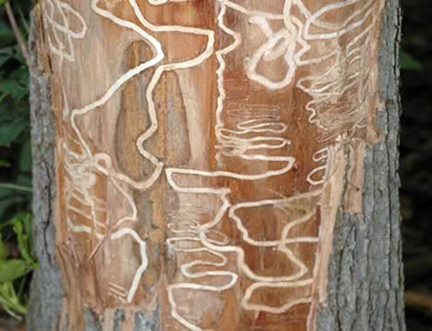An ash tree’s worst nightmare

By Susan Mates, Washington County Treekeepers

The emerald ash borer (EAB) beetle (Agrilus planipennis) is being called the most destructive forest pest in North America, and that’s saying something when you consider the devastation caused by other pests such as gypsy moths and bark beetles. These wood-boring pests are native to parts of Asia and were first detected in North America in 2002 — but now they are here in Oregon.
A Portland city biologist discovered evidence of the pest in June in Forest Grove, years ahead of when they were predicted to reach our state. In twenty short years, EAB have killed hundreds of millions of ash trees in the United States and have the potential to cause the local extinction of Oregon’s native ash species. That loss could result in wide-reaching economic impacts, damage water quality, create direct human health impacts, and endanger important cultural resources.
Cedar Mill and Bonny Slope have numerous Oregon Ash trees along our many streams, so as you walk our trails and explore the natural areas of our parks, keep your eyes open for any sign of this pest. [Susan wrote about them in the June issue.]

The EAB is a small (½ inch long) metallic-green jewel beetle. Their larvae burrow into the tree’s bark and then eat their way along the insides of the tree’s cambium and phloem. This creates tunnels that are invisible from the outside but prevent the tree from transporting enough water and nutrients to its extremities, eventually resulting in the tree’s death.
EABs aggressively kill both stressed and healthy trees, and no effective native predators or parasites have been found to date. Ash trees often do not show symptoms during the first years of an EAB infestation, so the beetles may go unnoticed for several years. After about four years the EAB larval density builds up to a critical mass that means rapid decline for the ash trees—too late to be saved.

Scientists and foresters have been preparing for this moment. They have been insisting on increased diversity in species when new trees are planted in order to protect the tree canopy as a whole. The state has created a repository of ash seeds that can help with an eventual replanting. And a diverse group of stakeholders has prepared a plan that we can only hope will serve to create EAB resilient communities.
Here is what you can do to help curb the spread of Emerald ash borers:
- Be aware of signs of the beetles and report them immediately.
- Don’t move firewood from one place to another, as that is one of the main ways they are thought to be spread.
- Keep your ash trees healthy and unstressed. For example, keep your trees watered during our summer drought.
- Learn to identify and locate ash trees. One way to do that is to assist Treekeepers of Washington County with their street tree inventory.
We face the devastation of whole habitat types such as ash swales and sensitive riparian zones as well as the reduction of our urban forest cover. The loss of ash trees by EAB mortality is expected to clear the way for invasive plants, alter the soil pH and moisture levels, increase soil erosion, and elevate stream temperatures. Once-forested areas will become shrub- or grasslands. In sensitive riparian corridors, those changes could be disastrous for many species of fish, freshwater mussels, and aquatic insects. Please help us include our entire community in being a part of the effort to save our ash trees.
Photos courtesy of USDA-APHIS: https://www.aphis.usda.gov/aphis/ourfocus/planthealth/plant-pest-and-disease-programs/pests-and-diseases/emerald-ash-borer/ct_gallery





